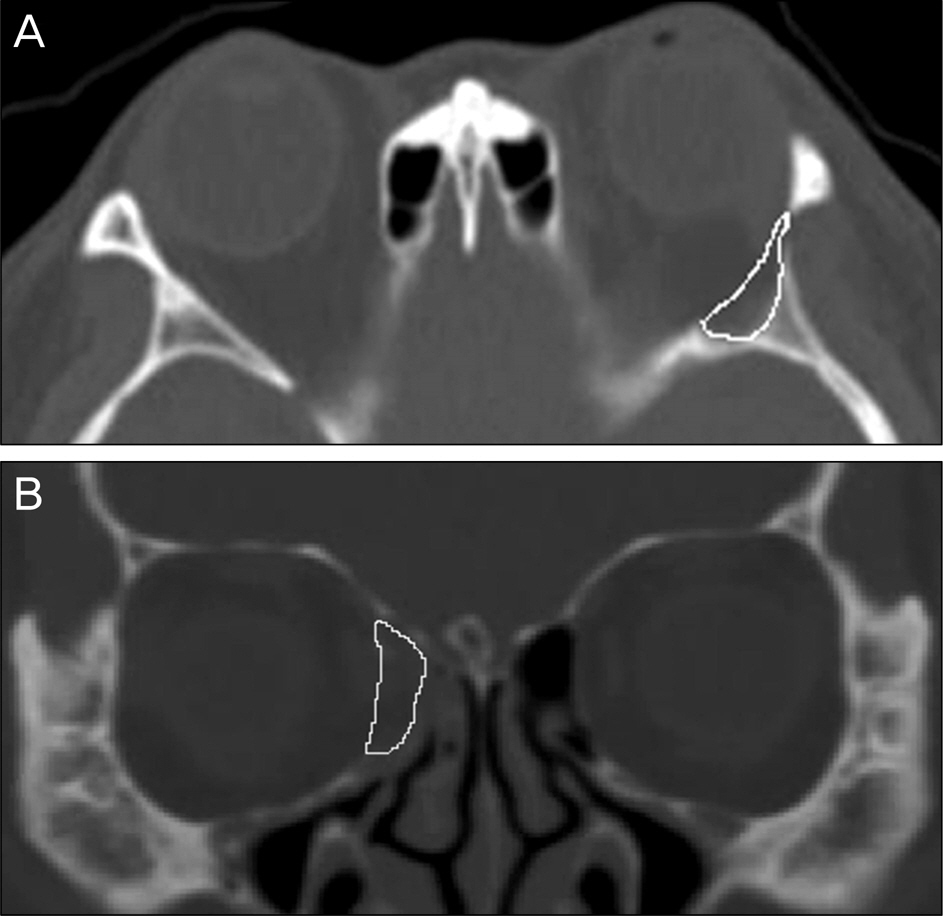J Korean Ophthalmol Soc.
2014 Mar;55(3):337-342. 10.3341/jkos.2014.55.3.337.
Evaluation of Stereotactic Navigation During Orbital Decompression in Thyroid-Associated Orbitopathy Patients
- Affiliations
-
- 1Department of Ophthalmology, Chung-Ang University College of Medicine, Seoul, Korea. lk1246@hanmail.net
- KMID: 2218259
- DOI: http://doi.org/10.3341/jkos.2014.55.3.337
Abstract
- PURPOSE
To evaluate the use of stereotactic navigation during orbital decompression surgery.
METHODS
We conducted a retrospective analysis of 27 patients (48 orbits) with thyroid-associated orbitopathy who underwent orbital decompression. Stereotactic navigation was performed on 28 orbits of 15 patients, and orbital decompression surgery without navigation was performed on 20 orbits of 12 patients. The changes in medial wall, lateral wall and inferior wall orbital volume in CT scans and horizontal and vertical eyeball deviation after surgery were analyzed in the 2 patient groups.
RESULTS
The mean decompressed volume of orbits was significantly increased in the lateral wall decompression with stereotactic navigation patient group than without stereotactic navigation (p < 0.05, p = 0.025). However, in the inferior wall and the medial wall decompression, there was no significant difference between the 2 groups. The changes of horizontal and vertical deviation were not significant between the 2 groups and no patient experienced neural damage.
CONCLUSIONS
The stereotactic navigation during lateral orbital wall decompression is a safe and effective method for inducing greater decompressed volume.
Figure
Cited by 2 articles
-
Treatment of Graves' Ophthalmopathy
Jeong Kyu Lee
Int J Thyroidol. 2019;12(2):91-96. doi: 10.11106/ijt.2019.12.2.91.Three Wall Orbital Decompression for Compressive Optic Neuropathy in Thyroid Ophthalmopathy
Ji Ah Song, Joo Yeon Kim, Soo Jung Lee, Jae Hwan Kwon
Korean J Otorhinolaryngol-Head Neck Surg. 2019;62(2):125-130. doi: 10.3342/kjorl-hns.2017.00479.
Reference
-
References
1. Bartalena L, Marocci C, Bogazzi F, et al. Glucocorticoid therapy of Graves' ophthalmopathy. Exp Clin Endocrinol. 1991; 97(2-3):320–7.
Article2. Bartalena L, Pinchera A, Marcocci C. Management of Graves' ophthalmopathy: reality and perspectives. Endocr Rev. 2000; 21:168–99.
Article3. Lyons CJ, Rootman J. Orbital decompression for disfiguring exophthalmos in thyroid orbitopathy. Ophthalmology. 1994; 101:223–30.
Article4. Fatourechi V, Garrity JA, Bartley GB, et al. Graves ophthalmopathy. Results of transantral orbital decompression performed primarily for cosmetic indications. Ophthalmology. 1994; 101:938–42.5. Garrity JA, Fatourechi V, Bergstralh EJ, et al. Results of transantral orbital decompression in 428 patients with severe Graves' ophthalmopathy. Am J Ophthalmol. 1993; 116:533–47.
Article6. Maroon JC, Kennerdell JS. Radical orbital decompression for severe dysthyroid exophthalmos. J Neurosurg. 1982; 56:260–6.
Article7. Graham SM, Brown CL, Carter KD, et al. Medial and lateral orbital wall surgery for balanced decompression in thyroid eye disease. Laryngoscope. 2003; 113:1206–9.
Article8. Apuzzo ML, Sabshin JK. Computed tomographic guidance stereo-taxis in the management of intracranial mass lesions. Neurosurgery. 1983; 12:277–85.
Article9. Andrews BT, Surek CC, Tanna N, Bradley JP. Utilization of computed tomography image-guided navigation in orbit fracture repair. Laryngoscope. 2013; 123:1389–93.
Article10. Cai EZ, Koh YP, Hing EC, et al. Computer-assisted navigational surgery improves outcomes in orbital reconstructive surgery. J Craniofac Surg. 2012; 23:1567–73.
Article11. Lee KY, Ang BT, Ng I, Looi A. Stereotaxy for surgical navigation in orbital surgery. Ophthal Plast Reconstr Surg. 2009; 25:300–2.
Article12. Patel BC. Stereotactic navigation for lateral orbital wall decompression. Eye (Lond). 2009; 23:1493–5.
Article13. Millar MJ, Maloof AJ. The application of stereotactic navigation surgery to orbital decompression for thyroid-associated orbitopathy. Eye (Lond). 2009; 23:1565–71.
Article14. Kennedy DW, Goodstein ML, Miller NR, Zinreich SJ. Endoscopic transnasal orbital decompression. Arch Otolaryngol Head Neck Surg. 1990; 116:275–82.
Article15. Metson R, Shore JW, Gliklich RE, Dallow RL. Endoscopic orbital decompression under local anesthesia. Otolaryngol Head Neck Surg. 1995; 113:661–7.
Article16. Dubin MR, Tabaee A, Scruggs JT, et al. Image-guided endoscopic orbital decompression for Graves' orbitopathy. Ann Otol Rhinol Laryngol. 2008; 117:177–85.
Article17. Reardon EJ. Navigational risks associated with sinus surgery and the clinical effects of implementing a navigational system for sinus surgery. Laryngoscope. 2002; 112(7 Pt 2 Suppl 99):1–19.
Article18. Kakizaki H, Nakano T, Asamoto K, Iwaki M. Posterior border of the deep lateral orbital wall--appearance, width, and distance from the orbital rim. Ophthal Plast Reconstr Surg. 2008; 24:262–5.
Article19. Oh DH, Lee JK. Surgical anatomy of deep lateral wall by adults ca-davers and computed tomography. J Korean Ophthalmol Soc. 2011; 52:964–9.
Article20. Ben Simon GJ, Syed HM, Lee S, et al. Strabismus after deep lateral wall orbital decompression in thyroid-related orbitopathy patients using automated hess screen. Ophthalmology. 2006; 113:1050–5.
Article21. Goldberg RA, Perry JD, Hortaleza V, Tong JT. Strabismus after balanced medial plus lateral wall versus lateral wall only orbital decompression for dysthyroid orbitopathy. Ophthal Plast Reconstr Surg. 2000; 16:271–7.
Article
- Full Text Links
- Actions
-
Cited
- CITED
-
- Close
- Share
- Similar articles
-
- Associations between Orbital Morphology and Exophthalmos Changes after Endoscopic Orbital Decompression to Treat Thyroid-related Orbitopathy
- The Clinical Result of Medial Orbital Decompression in Patients with Thyroid-associated Orbitopathy
- Change in Proptosis Following Extraocular Muscle Recession in Thyroid-Related Orbitopathy
- Long-term Result of Fat Orbital Decompression
- Endoscopic Orbital Decompression for Dysthyroid Orbitopathy




